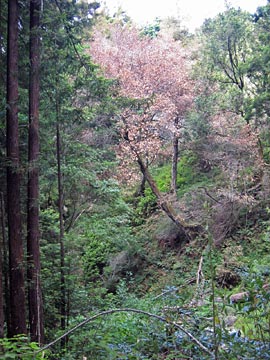UC Berkeley Press Release
 |
These tanoaks were killed by the Sudden Oak Death pathogen on Mount Tamalpais, near one of the sites where the exotic pathogen was first introduced in California. Infected ornamental plants were found to be the most likely source of the introduction. (Matteo Garbelotto/UC Berkeley photos) |
Sudden Oak Death pathogen is evolving, says new study that reconstructs the epidemic
BERKELEY – The pathogen responsible for Sudden Oak Death first got its grip in California's forests outside a nursery in Santa Cruz and at Mt. Tamalpais in Marin County before spreading out to eventually kill millions of oaks and tanoaks along the Pacific Coast, according to a new study led by researchers at the University of California, Berkeley. It provides, for the first time, evidence of how the epidemic unfolded in this state.
"In this paper, we actually reconstruct the Sudden Oak Death epidemic," said Matteo Garbelotto, UC Berkeley associate extension specialist and adjunct professor, and principal investigator of the study. "We point to where the disease was introduced in the wild and where it spread from those introduction points."
The study, scheduled to appear later this month in the online early edition of the journal Molecular Ecology, also shows that the pathogen is currently evolving in California, with mutant genotypes appearing as new areas are infested. These findings suggest that movement of infected plants between different regions where Sudden Oak Death is established should be minimized, said Garbelotto.
Garbelotto will present these findings today (Wednesday, April 16) at the annual meeting of the California Oak Mortality Task Force, a coalition of research institutions, public agencies, non-profit organizations and private industry formed to coordinate management, research, outreach and policy efforts surrounding Sudden Oak Death disease in California. Garbelotto is a member of the task force.
 Up to 100 percent of adult tanoaks have been killed by the Sudden Oak Death pathogen in many sites around the Big Sur region (Monterey County). Despite the extreme severity of the disease, the pathogen was introduced in the Big Sur region well after its introduction in Santa Cruz and Marin counties. Unfortunately, climatic conditions favorable to the pathogen have led to very rapid spread of SOD in this area. |
From the samples, the researchers identified 35 unique strains of the pathogen. A computer analysis further revealed how those strains were related to each other. The study found that all strains were originally derived from three basal strains that were most prevalent in the samples and common in all sites.
Armed with that information, the researchers then plotted out which regions were linked to the basal strains to create a history of the epidemic.
Two sites emerged as the origin of the basal strains: Bean Creek in Santa Cruz County, located just outside a nursery that had been shut down because of its Sudden Oak Death infestation, and the Bolinas Ridge site in Marin County's Golden Gate National Recreation Area on Mt. Tamalpais, only 5 kilometers from the site where the disease was first observed in California. The basal strains also matched those found in the nursery samples.
"Although our study identified two locations from which the Sudden Oak Death pathogen spread to other parts of California, the close proximity of the site in Santa Cruz to a nursery makes it highly probable that the epidemic began there rather than at Mt. Tam," said Garbelotto.
Garbelotto noted that previous research has already pointed to the international plant trade as having introduced the pathogen to the United States. The basal strains from the Santa Cruz and Mt. Tamalpais sites also matched the strains from the nursery samples in the study, providing further support for the key role nurseries played in the spread of the epidemic, he said.
The most likely scenario, said Garbelotto, is that the pathogen arrived in California through the nursery trade, and that it then spread from the nursery in Santa Cruz to trees bordering the facility. While the site at Mt. Tamalpais is not adjacent to a nursery, there is anecdotal evidence of frequent use of ornamental plants from nurseries in landscaping projects in the area, said Garbelotto.
Based upon the genetic analysis of this study, the disease could have then progressed to other parts of California's coast, including Sonoma County and Big Sur, according to the study.
"Interestingly, areas where the Sudden Oak Death infestation are particularly severe are not necessarily the first ones to have become infected," said Garbelotto. "Big Sur was hit particularly hard by Sudden Oak Death, with a proportionally larger amount of trees killed by the disease. That is why this historical reconstruction based upon genetic analysis is so important; it does not always match the picture of the epidemic one would develop based solely upon observations."
The fact that there are more symptoms and higher mortality in areas where the pathogen didn't originate suggests that some factor other than length of infestation, such as climate or environmental conditions, is needed for the pathogen to thrive, the researchers said.
To better understand how different areas ended up with matching strains, the researchers analyzed how far the pathogen can spread naturally, such as through airborne spores and wind gusts. To do this, GPS coordinates were recorded for every plant sampled, and the distance between plants with identical strains was calculated.
The researchers found that the vast majority of movement occurred within 200 to 300 meters. However, spores were occasionally found moving 1 to 5 kilometers, possibly aided by strong winds, they said.
"That means if we find a perfect match in strains at sites more than 10 kilometers apart, we can safely assume that the spread did not happen naturally, and that the pathogen was introduced to the site by some other means," said Garbelotto. "The Santa Cruz site is about 100 kilometers away from Mt. Tam, so it's clear that natural spread did not occur between the sites."
The study also found that strains from areas of recent infestations are more genetically distant from current nursery strains, which suggests that regulations controlling the spread of the pathogen from the nursery to the wild are working, said Garbelotto. "Nurseries do not seem to be the source of current outbreaks of Sudden Oak Death in the wild," he said. "Unfortunately, evidence shows that the pathogen is spreading on its own in the wild. New strains are evolving."
Previous research led by Garbelotto has shown that there was very little genetic variability of the pathogen in the forest, an indication that the pathogen was spreading by asexual, clonal reproduction in the wild. Samples from nurseries, however, revealed significantly greater genetic variation, suggesting that nurseries host a much broader representation of the pathogen.
But as the epidemic continues, strains of P. ramorum found in wild sites are beginning to show greater diversity, the researchers said.
Garbelotto noted that current regulations restrict the movement of known host plant material from natural areas within quarantine counties to non-restricted areas, but moving plant material within the quarantined counties is allowed.
"The sites within the quarantined areas are at different points in the epidemic's evolutionary history with different strains of the pathogen, so moving plants between those locations could be dangerous," said Garbelotto. "What our study shows is that not every infected site is the same."
Other UC Berkeley members of the research team are Silvia Mascheretti and Peter J. Croucher, both post-doctoral researchers in the Department of Environmental Science, Policy and Management.

